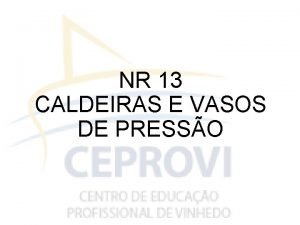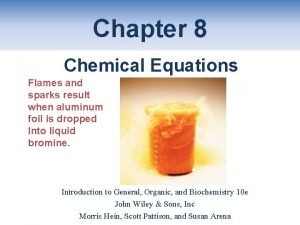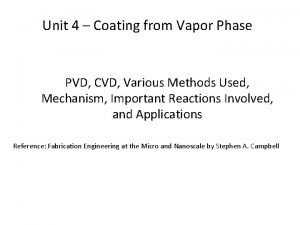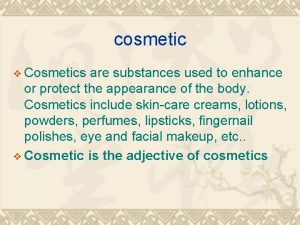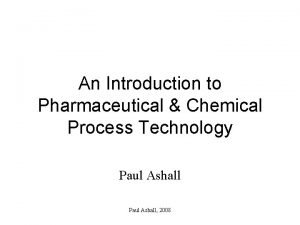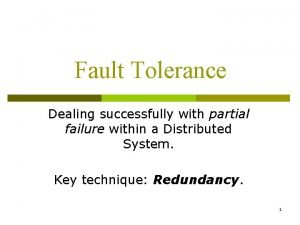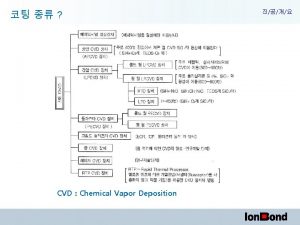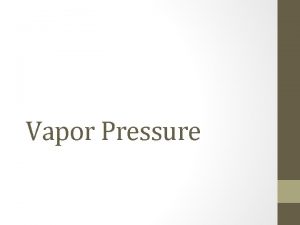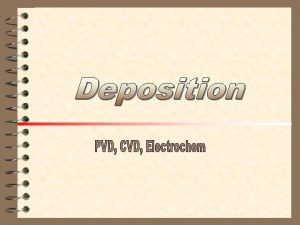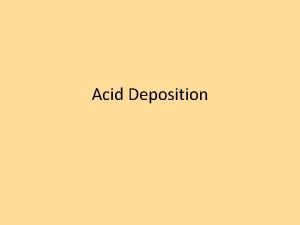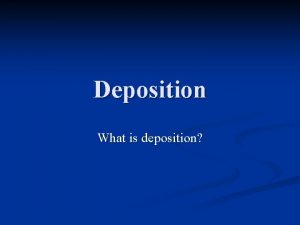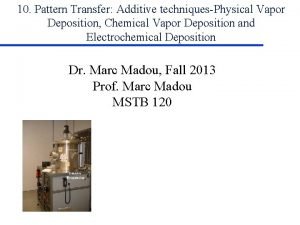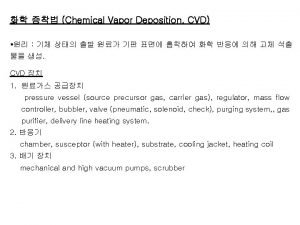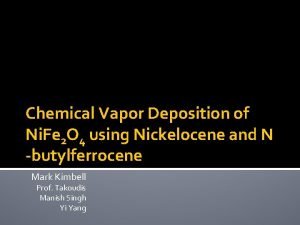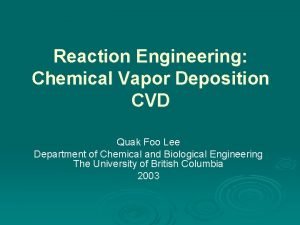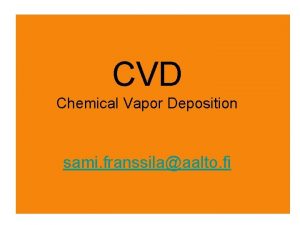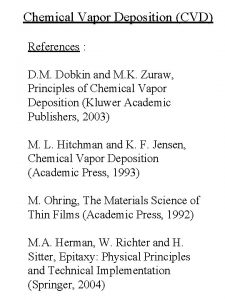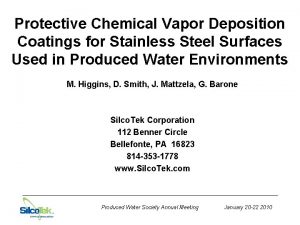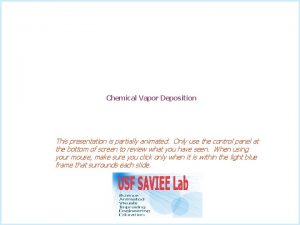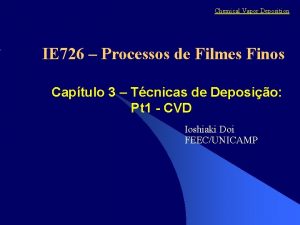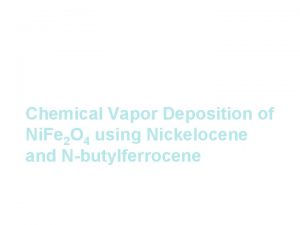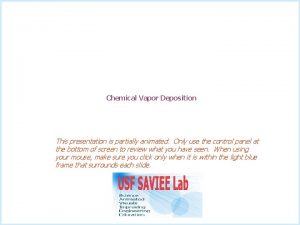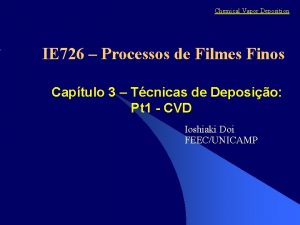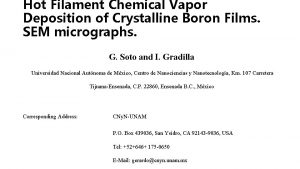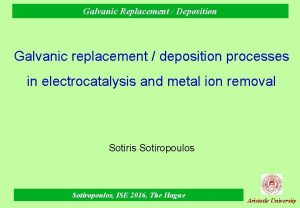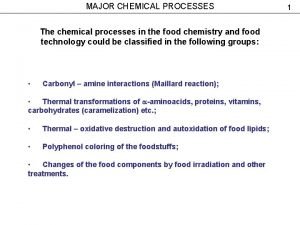Using Chemical Vapor Deposition Processes to Enhance the



























- Slides: 27

Using Chemical Vapor Deposition Processes to Enhance the Corrosion Performance of Steel Substrates Silco. Tek Corporation Gary Barone

Topics • • About Us Products and Applications Product Performance Conclusion/Future Product Development

APPLICATION AREAS • Silco. Nert™: Inertness • Silcolloy™: Anti-Corrosion • Silco. Klean™: Anti-Coking • Silco. Guard™: Ultra-High MARKET AREAS Analytical Pharmaceutical Environmental Petrochemical Chemical Process Semiconductor/Research Vacuum Automotive

Basic Manufacturing Process • Receive items • Document – digital, customer contact • Clean – Standard: caustic ultrasonic bath, 2 systems – Custom: solvation via other means • Chemical Vapor Deposition (CVD) Process – Vacuum – 400ºC – silicon-based deposition • Clean • Document – digital, customer contact • Pack, ship

Product Characterization • • Amorphous silicon CVD coating Density: 2. 33 g/cm 3 o Melting point: 1410 C Max operating temp. • 600 o. C to 1000 o. C: Silcolloy; Silco. Nert 1000; Silco. Guard • 450 o. C Silco. Nert 2000 • 1200 A to 5 um thickness, minimal smoothing of surface

Coating Cross Section 316 SS

Auger Depth Profile

Coating Capabilities: Substrates • Tubing: – 0. 004” to 0. 5” ID – 2000+ ft. continuous lengths • Complex geometry parts (inside and out) – Fittings, valves, frits – Block manifolds, sample vessels – custom parts

Sizes of reaction chambers • “Standard” vessels: – 12” diameter cylinder w/ 56” height – 6” diameter cylinder w/ 72” height – 10” diameter cylinder w/ 18” height – 21” diameter cylinder w/ 42” height • Large processing oven: – 27” diameter x 26” deep • Walk-in Oven: – 4 feet by 5 feet – 6 feet by 4 feet by 5 feet

Substrates Which Coat Well • • 300 and 400 grade stainless steel High carbon steel Titanium Ceramics Borosilicate glass Inconel® Hastelloy®

Substrates with Issues • • • Nickel / Nickel plating Aluminum* Monel® Copper Brass Gold and Silver plated components Chrome Plated components Magnesium Elastomers *heat-dependent

Corrosion Resistance of Coatings

Silcolloy™ Corrosion Resistance: • Stainless steel surfaces susceptible to attack from in chlorinated environments and acidic exhaust environments. • Corrosion resistant deposition is insoluble in hydrochloric acid and unaffected in salt water environments. Corrosion

Corrosion Resist studies • External Evaluation – Certified corrosion engineers (Matco) – Spectroscopic analysis – Mechanical testing – Electrochemical Cyclic Polarization in neutral, acidic, alkaline – Atmospheric corrosion • ASTM moisture condensation • Salt spray ASTM B 117 Corrosion – Stress corrosion cracking (Mg. Cl 2; ASTM G 36)

ASTM G 48 B Data: Pitting and Crevice Corrosion • ASTM G 48 method B; Pitting and Crevice Corrosion – 6% Ferric Chloride solution – 72 hrs, 20ºC – 316 L Stainless samples w/Gasket wrap Sample Initi Fina We Weig al l i ht Wei g Lo g g h ss h h t (g/m 2 t t Lo ) ( ( s g g s ) ) ( Corrosion g

ASTM G 48 B (cont. ) • Bare 316 L Stainless Steel coupon showing severe crevice corrosion Corrosion

ASTM G 48 B (cont. ) • Corrosion resistant treated sample showing no crevice corrosion and slight pitting corrosion Corrosion

ASTM G 61 Data: Cyclic Polarization • ASTM G-61; Cyclic Polarization Electrochemical Corrosion Testing – Acid, neutral, basic aqueous solutions with varying Cl- ion concentrations (100, 3000, 5000 ppm) – EG&G Versa. Stat System, 23ºC – 316 L vs. Silcolloy™ on 316 L & 304 L -CR vs 316 L Raw: 50 x improvement Neutral solution; 3000 ppm Cl- Ec = corrosion potential Ic = current density at Ec Eb = pitting potential CR = corrosion rate Sample Ec, m. V Ic, u. A/cm^2 Eb, m. V CR, mpy 316 L -418 0. 096 370 0. 04 Silcolloy™ 316 L -533 0. 002 1460 0. 0009 304 L -435 0. 145 361 0. 06 Corrosion

ASTM B 117 Data: Salt Spray • ASTM B 117 – “Practice for Operating Salt Spray (Fog) Apparatus. ” – 4000 hour exposure – 100 degree Fahrenheit – 3. 5% by weight sodium chloride • Reproduces exposure to marine environments. Corrosion

ASTM B 117 Data (cont. ) • Silcolloy™ treated samples showed no signs of bleeding, rusting, or pitting corrosion Corrosion

ASTM B 117 Data (cont. ) • The non-treated samples showed some light surface rusting, but no signs of pitting corrosion. Corrosion

ASTM D 4585 Data: Condensing Humidity • ASTM D 4585, “Practice for Testing the Water Resistance of Coatings Using Controlled Condensation. ” – 1000 hour study – 100 degrees Fahrenheit – Distilled water • Reproduces exposure to atmospheric conditions Corrosion

ASTM D 4585 (cont. ) • Silcolloy™ treated samples showed no signs of bleeding, rusting, or pitting corrosion Corrosion

Silcolloy™ Advantages • Longer Life: – Extend lifetimes of equipment exposed to corrosive environments and/or process streams • Protection: – Protection of high value equipment in corrosive environments • Inert: – Provide enhanced corrosion resistance to analytical equipment while maintaining inert sample pathway • High Temperature: Corrosion – High temperature stability up to 1000 c

Silcolloy™ Applications • Manufacturing/Chemical – Process streams containing HCl • Environmental – Continuous Emissions Monitoring exposed to stack gases from coal fired plants and incinerators • Automotive – Equipment used in Automotive Exhaust testing and catalytic converter studies – Diesel EGR & Turbo systems • Marine – Some preliminary evaluation of coating in marine Corrosion environments (offshore platforms)

Conclusions/Future • Continual process improvement and new product development for coatings: – Improving the hardness of coatings – Improved corrosion resistant coatings – Hydrophobic surfaces for moisture sensitive applications – Protection of high nickel alloys such as Hastelloy® and Inconel® – Hydrogen embrittlement resistance.

QUESTIONS ?
 Vapor saturado e vapor superaquecido
Vapor saturado e vapor superaquecido Wiley
Wiley Chemical vapour deposition
Chemical vapour deposition Concurrent processes are processes that
Concurrent processes are processes that Grammar to enrich and enhance writing
Grammar to enrich and enhance writing The most daring and wild designs
The most daring and wild designs Enhance an image
Enhance an image Cspnet
Cspnet Vcosmetics
Vcosmetics Enhance an image
Enhance an image Nus grading system
Nus grading system Enhance life
Enhance life Type of salad which stimulate one’s appetite.
Type of salad which stimulate one’s appetite. Can hypnosis enhance recall of forgotten events
Can hypnosis enhance recall of forgotten events Enumerate the market forms of meat.
Enumerate the market forms of meat. Chemical processes
Chemical processes Partial failure meaning
Partial failure meaning Section 2 classifying chemical reactions worksheet answers
Section 2 classifying chemical reactions worksheet answers Chapter 7 chemical formulas and chemical compounds test
Chapter 7 chemical formulas and chemical compounds test Section 2 classifying chemical reactions worksheet answers
Section 2 classifying chemical reactions worksheet answers Section 1 chemical changes
Section 1 chemical changes Chapter 7 review modern chemistry answers
Chapter 7 review modern chemistry answers Chapter 18 chemical reactions balancing chemical equations
Chapter 18 chemical reactions balancing chemical equations Hình ảnh bộ gõ cơ thể búng tay
Hình ảnh bộ gõ cơ thể búng tay Ng-html
Ng-html Bổ thể
Bổ thể Tỉ lệ cơ thể trẻ em
Tỉ lệ cơ thể trẻ em Voi kéo gỗ như thế nào
Voi kéo gỗ như thế nào
